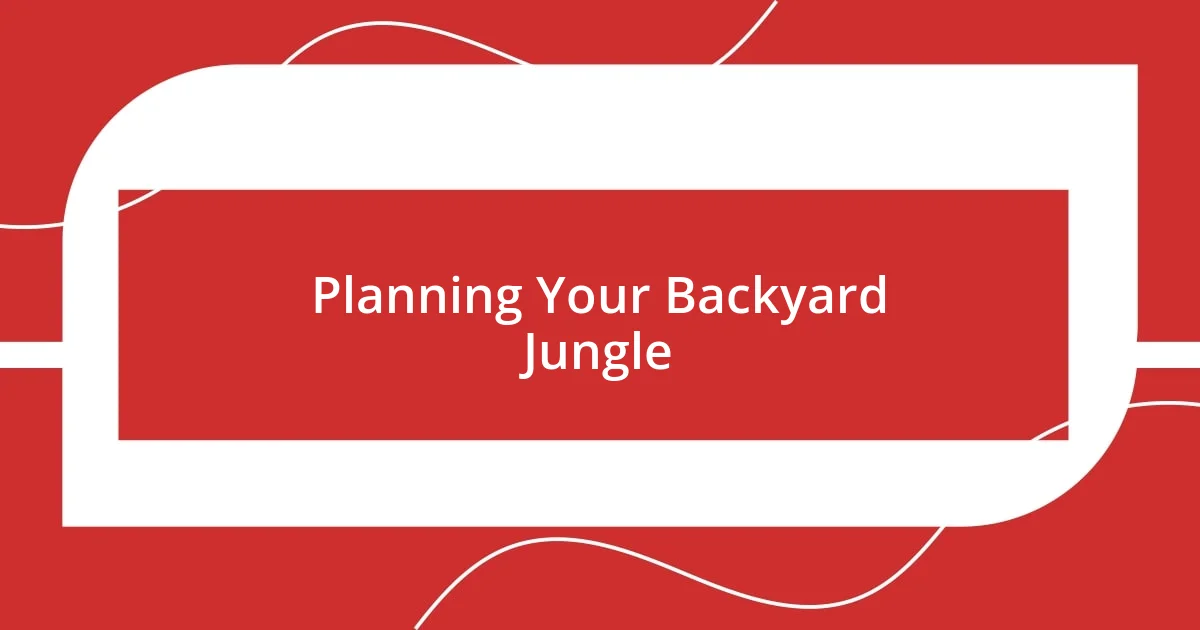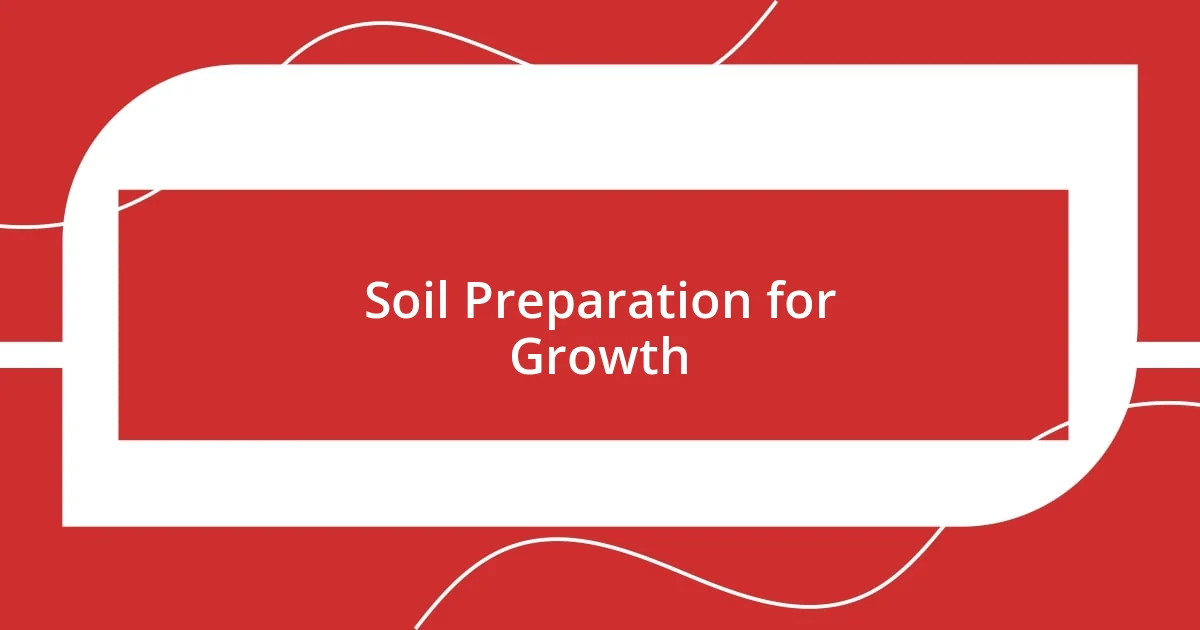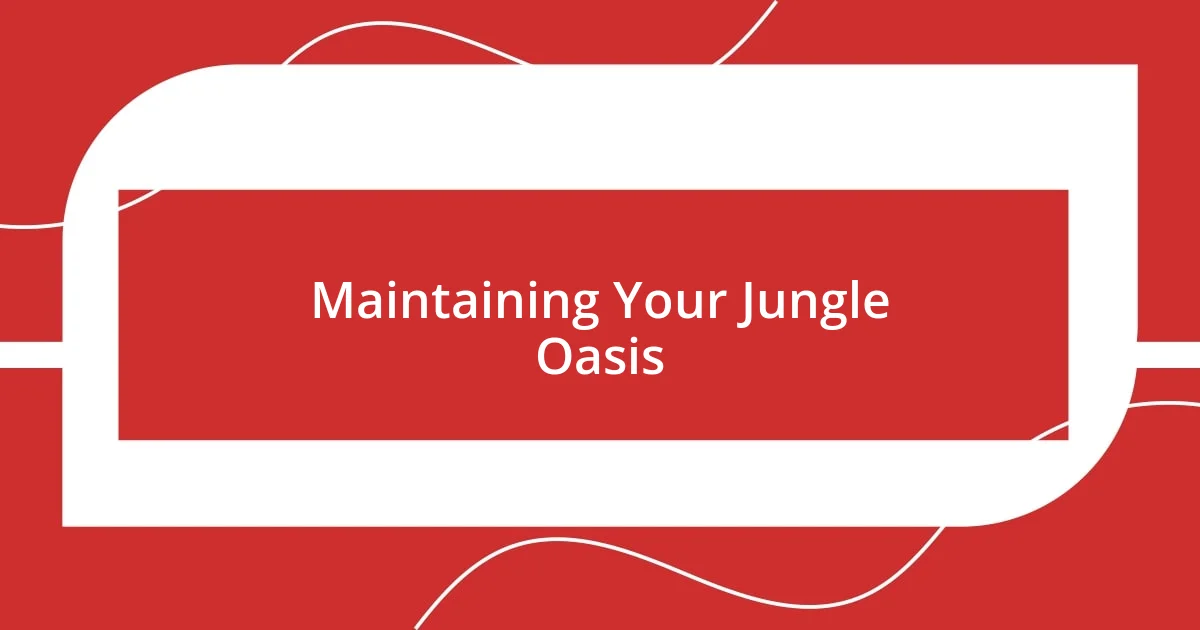Key takeaways:
- Effective planning involves considering sunlight, desired plant types, and pathways to shape the backyard’s atmosphere.
- Soil preparation is crucial for plant health; using organic matter and aerating the soil can significantly improve growth conditions.
- Attracting wildlife enhances the garden’s vibrancy; adding native plants and water sources creates habitats and supports local ecosystems.

Planning Your Backyard Jungle
When I first envisioned my backyard jungle, I felt both excitement and overwhelm. I started by sketching a rough layout, considering where sunlight hit the yard throughout the day. Does your space have areas that are bathed in sun or shaded by trees? Understanding these factors will help you choose the right plants for the right spots, preventing disappointment down the line.
As I mapped out my garden, I made a list of plants that sparked joy in me—like hibiscus for their vibrant blooms and ferns for their lush greenery. There’s something deeply fulfilling about selecting plants that reflect your personality and create an emotional connection. Imagine walking through your jungle, surrounded by your favorite florals and textures; isn’t that a dream worth chasing?
I also thought about how I wanted to navigate the space. Would I create winding paths through dense foliage or open areas to gather with friends? This decision shaped not just the layout, but also the vibe of my backyard. Think about how you want to use your jungle—will it be a personal retreat, a gathering place, or both? Planning is essential, as it sets the tone for your jungle adventure.

Choosing the Right Plants
Choosing the right plants for your backyard jungle is a thrilling endeavor. I found myself completely immersed in research, flipping through gardening books and browsing online forums. It was fascinating to discover how certain plants thrive in specific climates and soil types. I often compared potential additions like towering palms against delicate orchids—each bringing a unique vibe. Here’s a simple comparison to illustrate the differences:
| Plant Type | Ideal Conditions |
|---|---|
| Palms | Full sun, well-drained soil |
| Orchids | Partial shade, moisture-retentive soil |
As I built my jungle, I realized that diversity was key. Mixing larger statement plants with smaller, ground-cover varieties created layers of beauty. I remember planting a vibrant bougainvillea next to softer hostas. The contrast just popped! It warmed my heart to see how different plant textures and colors interacted. It’s this interplay that adds depth and intrigue to the landscape.
Don’t forget to consider the maintenance these plants require! I learned the hard way that some plants needed more attention than I could offer. After a few weeks of neglect, my once-proud azaleas started to wilt. It was a gentle reminder to choose plants that align not just with my vision but also with my willingness to care for them. A jungle can be as wild or as tame as you decide, reflecting your rhythm and lifestyle.

Soil Preparation for Growth
Soil preparation was one of those crucial steps that I initially overlooked in my excitement. After clearing the area, I simply couldn’t resist jumping straight into planting. But soon enough, I realized that without nurturing the soil, my dreams could quickly turn into a patch of disappointment. I spent a weekend turning the soil over with a garden fork and adding organic matter. It was surprisingly satisfying to feel the texture transform from hard and compacted to soft and crumbly, like creating a rich bed for my plants to thrive.
Here’s a quick checklist for effective soil preparation:
- Clear the Area: Remove weeds, rocks, and any debris to create a clean slate.
- Test the Soil: I bought a simple pH test kit to understand whether my soil was acidic, neutral, or alkaline. This helped me choose the right plants.
- Add Organic Matter: Compost and well-rotted manure are game changers. They not only improve soil texture but also boost the nutrient content.
- Aerate the Soil: Loosening the soil improves drainage and root penetration. I used a garden fork to aerate mine, which made a noticeable difference.
- Mulch: Once my plants were in, I added a layer of mulch to retain moisture and suppress weeds. It was like giving my jungle a cozy blanket.
I can’t express how pivotal this process was. As my plants began to settle in, I would often sit cross-legged in my yard, admiring their progress. Each new leaf felt like a small victory, a sign that my backyard jungle was becoming a reality, one step at a time.

Creating a Watering System
Creating a watering system was an adventure in itself. I initially thought that a simple hose would do the trick, but I quickly found out how crucial it is to have a reliable and efficient setup. After a few days of watering by hand, I began to feel overwhelmed—especially during those scorching summer days. That’s when I decided to invest in a drip irrigation system, which has proven to be a game changer for maintaining the lushness of my jungle.
Setting up the drip system required a bit of planning, but the process was surprisingly fun. I measured the distances between my plants and sketched a rough layout, imagining how water would flow through my little oasis. I remember the moment I tested it for the first time, watching as the tiny droplets worked their magic. It felt incredibly satisfying to know that each plant was receiving just the right amount of moisture. Have you ever experienced that joy of seeing your hard work pay off? That’s exactly how I felt!
Now, I can relax knowing my plants are well-watered without my constant intervention. I’ve even added a timer to the system, which takes the guesswork out of scheduling. This leaves me free to enjoy my garden rather than labor in it. Reflecting on this, I realized the importance of creating a system that fits seamlessly into your lifestyle. Isn’t it amazing how a little bit of planning can transform your gardening experience?

Designing Pathways and Layout
Designing pathways in my backyard jungle was a delightful challenge. I wanted my pathways to feel natural, like they’ve always been there. I chose stone pavers surrounded by lush greenery, which created a stunning contrast. As I laid each piece, I could almost hear the whisper of the leaves around me, making it feel like I was crafting my very own nature trail. Did you ever walk through a garden and wish you could lose yourself in its beauty? That’s exactly what I aimed to achieve.
I also had to think about how the layout would guide my visitors. I remember one afternoon, pacing back and forth, trying to envision how people would traverse my jungle. I wanted it to feel like an adventure, leading them from one surprise to the next. By creating curvy paths that meandered through clusters of plants, I could evoke a sense of discovery. The thrill of seeing someone’s eyes light up upon finding a hidden flower or a cozy bench was just priceless.
Durability was another consideration I couldn’t ignore, especially with the wildlife I attract. I opted for gravel-based paths, as they could withstand the weather and the occasional playful encounter with my pet. I found it fascinating how the textures of the stones complemented the various plant groups. It’s like each element on the pathway speaks to the other, creating a harmonious environment. Have you thought about how the right materials can enhance the overall feel of your garden? Trust me, it’s worth considering as you divert from ordinary to extraordinary!

Maintaining Your Jungle Oasis
Maintaining my jungle oasis has turned into a rewarding ritual that brings me closer to nature. I must admit, in the beginning, I felt overwhelmed by the sheer volume of plants and their needs. But over time, I learned to observe my surroundings—like when I noticed certain leaves turning yellow. It clinched my understanding that they needed more nutrients, prompting me to dive into the world of organic fertilizers. I must ask: have you ever felt that rush of excitement when you realize a small tweak in care transforms a struggling plant into something vibrant?
Another aspect of upkeep I found crucial is regular pruning. At first, I was hesitant to “cut back” my beloved plants, fearful I might ruin their beauty. However, I quickly discovered that pruning not only encourages healthy growth but also allows my light to penetrate the dense foliage. One time, while snipping back some overgrown branches, I stumbled upon a hidden cluster of colorful flowers that had been obscured. It felt like unveiling a secret treasure, emphasizing how the right care can reveal the full potential of your garden.
Lastly, pest management is a vital piece of this puzzle. I know the heartache of discovering a plant riddled with tiny holes and knowing something was munching away. After experimenting with natural repellents, I found that planting marigolds helped keep pests at bay while adding pops of color to my oasis. Have you tried integrating companion planting in your garden? It was a game changer for me and fostered a sense of balance and harmony within my greenery—almost like a natural alliance in the wild.

Attracting Wildlife to Your Garden
Attracting wildlife to my garden was one of the most surprising delights of transforming my backyard into a vibrant jungle. I began by creating habitats through varied plant heights and types, which offered both shelter and food. I still remember the first time a family of black-capped chickadees flitted about, exploring the branches of my tall sunflowers. Their cheerful songs filled the air, and I couldn’t help but smile, thinking about how my choices had invited such joyful visitors.
I also found adding a water source was key to encouraging wildlife to stop by. After installing a small birdbath, I was amazed at how quickly it became a gathering place. I could sit for hours, watching birds of different colors take turns splashing around, invigorated by the refreshing water. Have you ever noticed how the simple act of providing clean water can create a social hub for birds? There’s an undeniable magic to seeing nature come alive in your own space.
Lastly, I made an effort to plant native species which are particularly appealing to local wildlife. I remember planting a butterfly bush, and within days, vibrant butterflies started to dance around my garden. It was like turning on a switch that illuminated my backyard in ways I hadn’t anticipated. This experience made me realize: have you considered how native plants can help support local ecosystems? It’s remarkable how something as simple as selecting the right plants can enhance biodiversity and turn your garden into a lively celebration of nature.













